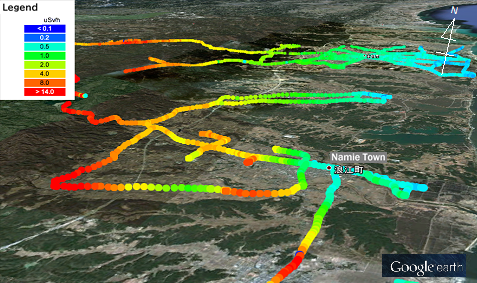Assessment of Exposure Doses and Decontamination
(2014)
QWhy are radiation doses measured with personal dosimeters different from those estimated using air dose rates?
AMany reasons explain the differences between measured and estimated values.
Possible causes of differences
- Air dose rate in an area where radioactive materials are deposited fluctuates depending on the place. But this fluctuation is not considered in the evaluation.
(Example)
・As an outdoor dose rate, data in a spot is used as a representative value.
・Indoor dose rate is 0.4 times of outdoor one. - As for the occupation time in each place, simple assumptions are generally used.
(Example)
・It is supposed that a person stays in house for 16 hours, and stays outside for 8 hours.
- Conversion coefficient c from ambient dose equivalent rate (air dose rate) to effective dose for an adult is about 0.6. But this value is often supposed to be 1 to be conservative.

Fig.1 Air dose rates distribution in northwestern side of Fukushima Dai-ichi measured by car survey
There might be sudden changes in air dose rates even in narrow area.
Considering the cause of errors in evaluation of radiation doses shown in the right column, the precision of evaluation method based on air dose rate needs to be increased. Such an attempt has already begun.
Related articles
- In what ways does exposure to radiation occur the environment? What kinds of radiation exposures are important in Fukushima?
- What methods are there for measurement and evaluation of external radiation doses? What are the characteristics of each method?
- Is it possible to precisely estimate radiation doses from air dose rates?
- Does the radiation dose measured with a personal dosimeter represent the real radiation dose?
